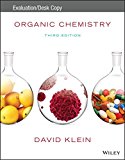
(a)
Interpretation:
The reagents that perform given transformation has to be identified.
Concept introduction:
Elimination reaction: In elimination reaction, two substituents are removed from the substrate to give the product in presence of base. Elimination of compound in presence of bulky base leads to less substituted
Addition reaction: In addition reaction, two substituents are added to the reactant without losing any compound.
Hydro-halogenation: Hydrogen and halogen added across the double bond of the alkene in Markovnikov’s path is called hydro halogenation. This addition reaction proceeds via anti-Markovnikov’s path in presence of peroxides.
(b)
Interpretation:
The reagents that perform given transformation has to be identified.
Concept introduction:
Elimination reaction: In elimination reaction, two substituents are removed from the substrate to give the product in presence of base. Elimination of compound in presence of bulky base leads to less substituted alkene, in presence of strong base (not bulky) leads to more substituted alkene.
Addition reaction: In addition reaction, two substituents are added to the reactant without losing any compound.
Hydro-halogenation: Hydrogen and halogen added across the double bond of the alkene in Markovnikov’s path is called hydro halogenation. This addition reaction proceeds via anti-Markovnikov’s path in presence of peroxides.
(c)
Interpretation:
The reagents that perform given transformation has to be identified.
Concept introduction:
Elimination reaction: In elimination reaction, two substituents are removed from the substrate to give the product in presence of base. Elimination of compound in presence of bulky base leads to less substituted alkene, in presence of strong base (not bulky) leads to more substituted alkene.
Addition reaction: In addition reaction, two substituents are added to the reactant without losing any compound.
Hydro-halogenation: Hydrogen and halogen added across the double bond of the alkene in Markovnikov’s path is called hydro halogenation. This addition reaction proceeds via anti-Markovnikov’s path in presence of peroxides.
(d)
Interpretation:
The reagents that perform given transformation has to be identified.
Concept introduction:
Elimination reaction: In elimination reaction, two substituents are removed from the substrate to give the product in presence of base. Elimination of compound in presence of bulky base leads to less substituted alkene, in presence of strong base (not bulky) leads to more substituted alkene.
Addition reaction: In addition reaction, two substituents are added to the reactant without losing any compound.
Hydro-halogenation: Hydrogen and halogen added across the double bond of the alkene in Markovnikov’s path is called hydro halogenation. This addition reaction proceeds via anti-Markovnikov’s path in presence of peroxides.
Want to see the full answer?
Check out a sample textbook solution
Chapter 8 Solutions
Organic Chemistry 3rd.ed. Klein Evaluation/desk Copy
- State the name and condensed formula of isooxazole obtained by reacting acetylacetone and hydroxylamine.arrow_forwardState the name and condensed formula of the isothiazole obtained by reacting acetylacetone and thiosemicarbazide.arrow_forwardProvide the semi-developed formula of isooxazole obtained by reacting acetylacetone and hydroxylamine.arrow_forward
- Given a 1,3-dicarbonyl compound (R1-CO-CH2-CO-R2), indicate the formula of the compound obtaineda) if I add hydroxylamine (NH2OH) to give an isooxazole.b) if I add thiosemicarbazide (NH2-CO-NH-NH2) to give an isothiazole.arrow_forwardAn orange laser has a wavelength of 610 nm. What is the energy of this light?arrow_forwardThe molar absorptivity of a protein in water at 280 nm can be estimated within ~5-10% from its content of the amino acids tyrosine and tryptophan and from the number of disulfide linkages (R-S-S-R) between cysteine residues: Ε280 nm (M-1 cm-1) ≈ 5500 nTrp + 1490 nTyr + 125 nS-S where nTrp is the number of tryptophans, nTyr is the number of tyrosines, and nS-S is the number of disulfide linkages. The protein human serum transferrin has 678 amino acids including 8 tryptophans, 26 tyrosines, and 19 disulfide linkages. The molecular mass of the most dominant for is 79550. Predict the molar absorptivity of transferrin. Predict the absorbance of a solution that’s 1.000 g/L transferrin in a 1.000-cm-pathlength cuvet. Estimate the g/L of a transferrin solution with an absorbance of 1.50 at 280 nm.arrow_forward
- In GC, what order will the following molecules elute from the column? CH3OCH3, CH3CH2OH, C3H8, C4H10arrow_forwardBeer’s Law is A = εbc, where A is absorbance, ε is the molar absorptivity (which is specific to the compound and wavelength in the measurement), and c is concentration. The absorbance of a 2.31 × 10-5 M solution of a compound is 0.822 at a wavelength of 266 nm in a 1.00-cm cell. Calculate the molar absorptivity at 266 nm.arrow_forwardHow to calculate % of unknown solution using line of best fit y=0.1227x + 0.0292 (y=2.244)arrow_forward
- Given a 1,3-dicarbonyl compound, state the (condensed) formula of the compound obtaineda) if I add hydroxylamine (NH2OH) to give an isooxazole.b) if I add thiosemicarbazide (NH2-CO-NH-NH2) to give an isothiazole.arrow_forwardComplete the following acid-base reactions and predict the direction of equilibrium for each. Justify your prediction by citing pK values for the acid and conjugate acid in each equilibrium. (a) (b) NHs (c) O₂N NH NH OH H₁PO₁arrow_forward23.34 Show how to convert each starting material into isobutylamine in good yield. ཅ ནད ཀྱི (b) Br OEt (c) (d) (e) (f) Harrow_forward
 ChemistryChemistryISBN:9781305957404Author:Steven S. Zumdahl, Susan A. Zumdahl, Donald J. DeCostePublisher:Cengage Learning
ChemistryChemistryISBN:9781305957404Author:Steven S. Zumdahl, Susan A. Zumdahl, Donald J. DeCostePublisher:Cengage Learning ChemistryChemistryISBN:9781259911156Author:Raymond Chang Dr., Jason Overby ProfessorPublisher:McGraw-Hill Education
ChemistryChemistryISBN:9781259911156Author:Raymond Chang Dr., Jason Overby ProfessorPublisher:McGraw-Hill Education Principles of Instrumental AnalysisChemistryISBN:9781305577213Author:Douglas A. Skoog, F. James Holler, Stanley R. CrouchPublisher:Cengage Learning
Principles of Instrumental AnalysisChemistryISBN:9781305577213Author:Douglas A. Skoog, F. James Holler, Stanley R. CrouchPublisher:Cengage Learning Organic ChemistryChemistryISBN:9780078021558Author:Janice Gorzynski Smith Dr.Publisher:McGraw-Hill Education
Organic ChemistryChemistryISBN:9780078021558Author:Janice Gorzynski Smith Dr.Publisher:McGraw-Hill Education Chemistry: Principles and ReactionsChemistryISBN:9781305079373Author:William L. Masterton, Cecile N. HurleyPublisher:Cengage Learning
Chemistry: Principles and ReactionsChemistryISBN:9781305079373Author:William L. Masterton, Cecile N. HurleyPublisher:Cengage Learning Elementary Principles of Chemical Processes, Bind...ChemistryISBN:9781118431221Author:Richard M. Felder, Ronald W. Rousseau, Lisa G. BullardPublisher:WILEY
Elementary Principles of Chemical Processes, Bind...ChemistryISBN:9781118431221Author:Richard M. Felder, Ronald W. Rousseau, Lisa G. BullardPublisher:WILEY





